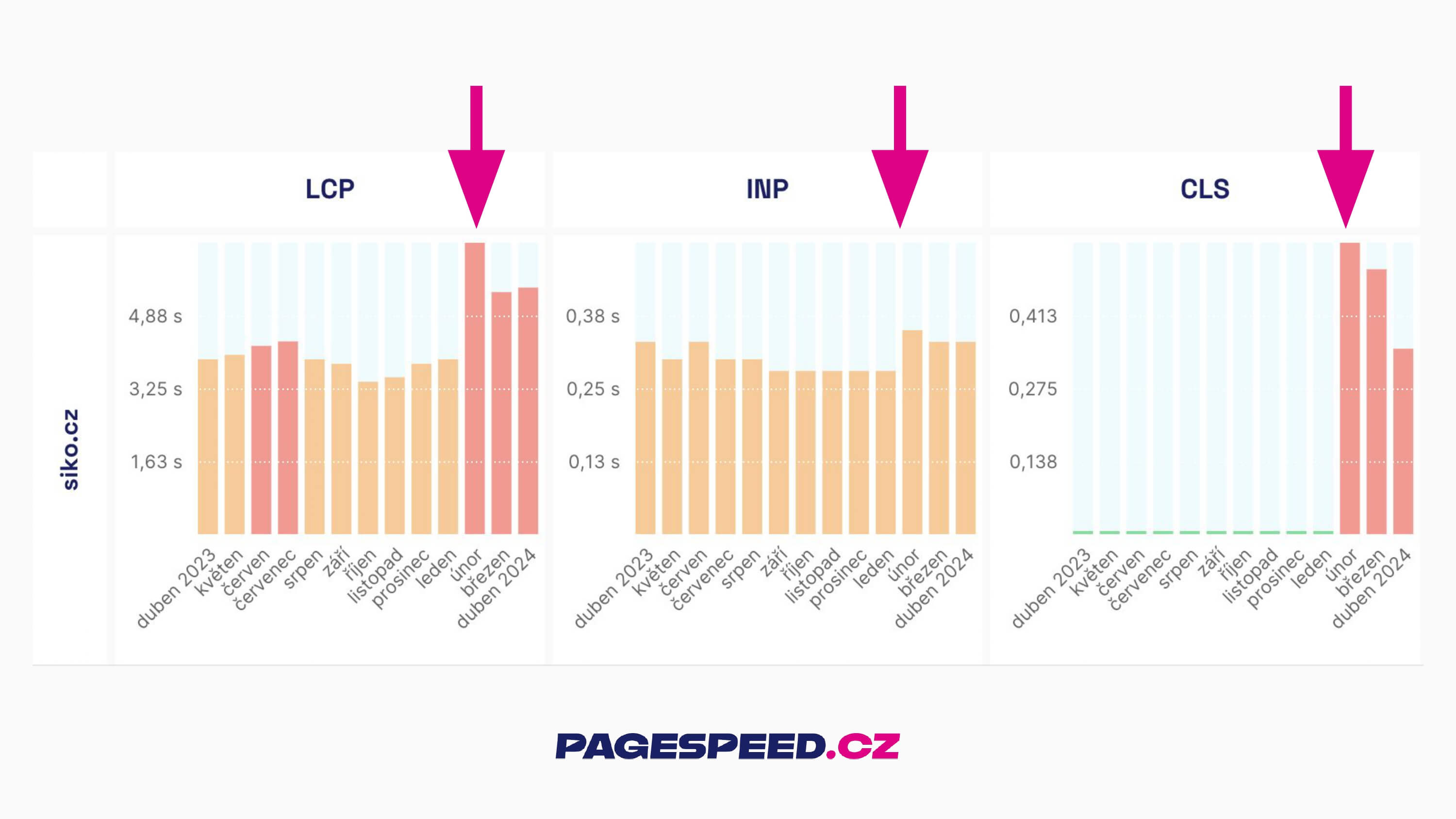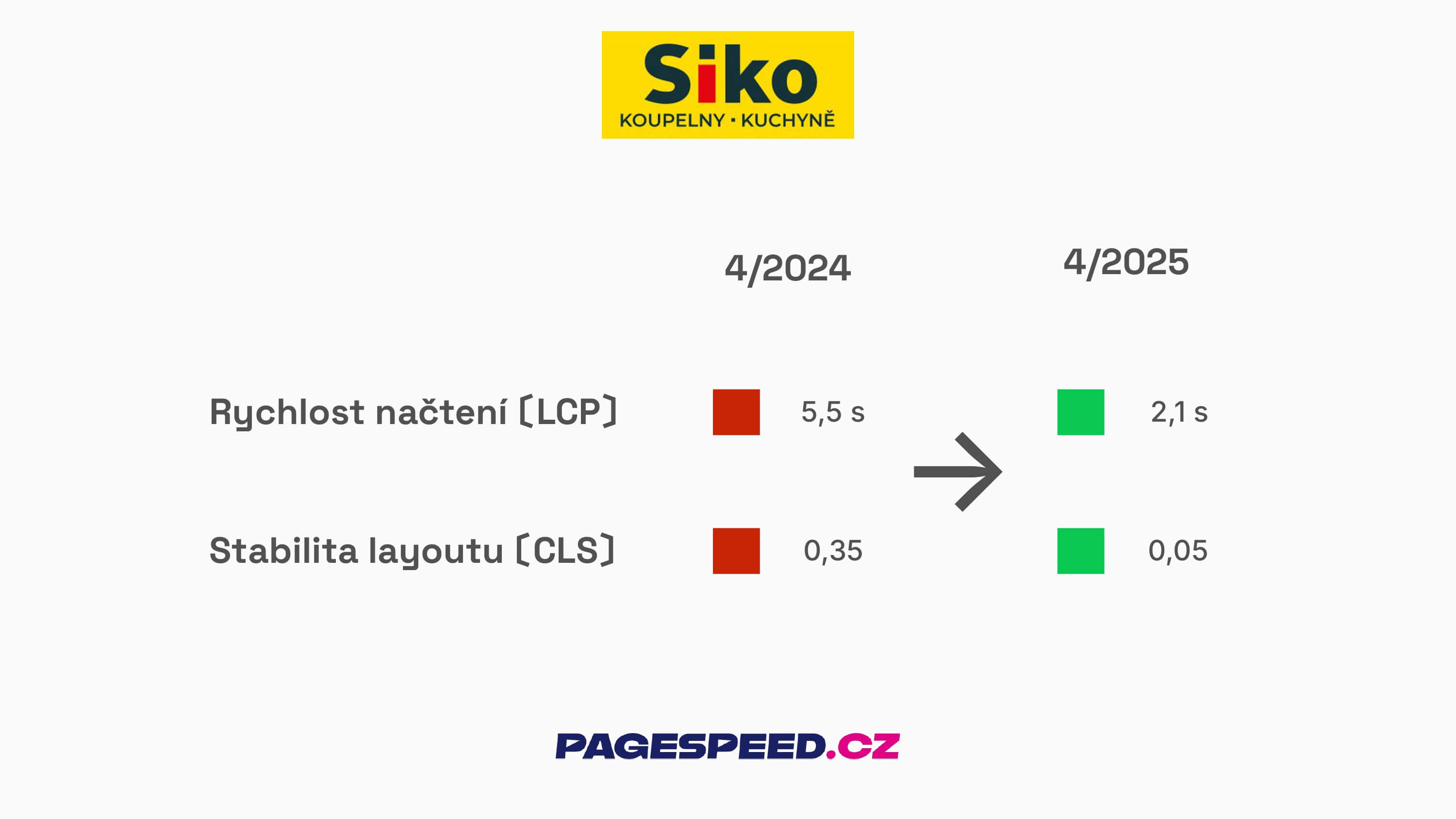SIKO Case Study: 2.5x Faster Load Times and 7x Better Layout Stability
SIKO is one of the largest bathroom and kitchen retailers in Central Europe, with a vast e-commerce presence in the Czech Republic, Slovakia, and Hungary.
Website speed is crucial for SIKO, but the new JavaScript-based frontend showed significant issues with Core Web Vitals user experience metrics.
 After launching the new website in February 2024, we observed a decline in loading speed (LCP) and layout stability (CLS) on mobile devices.
After launching the new website in February 2024, we observed a decline in loading speed (LCP) and layout stability (CLS) on mobile devices.
Following the website redesign, we collaborated with SIKO's e-commerce team to fine-tune the performance of the new site.
How did we work on speeding up SIKO's website?
During the speed optimization process for SIKO's websites, we proceeded as follows:
- The SIKO team involved all key partners, including us, in a regular performance tuning process.
- We identified optimization opportunities, assigned them to developers, and maintained communication with them.
- We implemented speed monitoring supplemented by SpeedCurve RUM.
- We reported the status to the client and shared our know-how.
Selected adjustments made possible through cross-team collaboration included:
- A partial shift from client-side rendering (CSR) to server-side rendering (SSR).
- Improved infrastructure settings (caching static resources, using WebP images, implementing Cloudflare, and more).
- Eliminating duplicate rendering of the main image on product detail pages.
- Layout optimizations for headers, filters, and galleries on product detail pages.
- Ongoing optimization of unwanted layout shifts (CLS).
- Optimizing the rendering of the website's main navigation.
- Changing the implementation of lazy loading.
- Adjusting image settings in the CMS.
- Modifications to loaders and skeletons.
The graph shows the difference in loading speed between the server-rendered page (SSR) and the original client-side version (CSR):
 With SSR, the page can render significantly faster—without waiting for JavaScript processing in the browser.
With SSR, the page can render significantly faster—without waiting for JavaScript processing in the browser.
As a bonus, we corrected the Google Analytics measurement at the start of our collaboration, which was ironically malfunctioning due to excessive speed optimization.
Impact of Collaboration
During a year of collaboration, we managed to significantly improve key loading speed (LCP) and layout stability (CLS) thanks to the involvement of all parties.
This wouldn’t have been possible without the excellent collaboration with the SIKO team, who were clear about their priorities and business goals.
Martin Lipový says about our collaboration:
Rather than seeing PageSpeed.ONE experts as external consultants, we view them as experienced colleagues in performance working within the same team focused on creating a functional and fast eCommerce website.
Martin Lipový, Head of Online and Product Development
 We improved loading speed (LCP) by 62% year-over-year and layout stability (CLS) by 86%.
We improved loading speed (LCP) by 62% year-over-year and layout stability (CLS) by 86%.
However, it’s not just about metrics; our collaboration also enhanced the overall user experience:
- More than 2.5 times faster loading on mobile (LCP).
- 7 times better layout stability (CLS).
- 2-5% lower bounce rate across various language versions.
- +17% increase in search visibility year-over-year (Source: Google Search Console Q1/2024 vs. Q1/2025)
Work on speed never ends
After several months of intensive collaboration, we continue with further minor adjustments. We maintain regular contact, monitor speed for the client, and train the internal testing team as part of building a “speed culture.”
Through this collaboration with the SIKO team, we demonstrated that even architectures heavily reliant on client-side JavaScript can experience significant speed improvements.By speeding up the website and improving Core Web Vitals, SIKO also gained a more stable foundation for marketing campaigns and expansion into new markets. Further optimizations await us as a standard part of development.